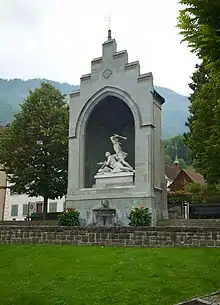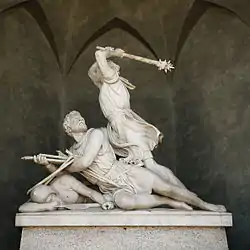Winkelried Memorial
The Winkelried memorial was erected in memory of Arnold von Winkelried, who sacrificed his life in the Battle of Sempach on the 9 July 1386. According to the Swiss historiography, the Swiss wouldn't be able to break through the firmly positioned order of Habsburg pikemen. At a moment, Winkelried decided to throw himself into the pikes and therefore open a passage through the Austrian defensive front, which made way for an attack of the Swiss confederacy which then led to a Swiss victory in the Battle of Sempach.[1]


The initiative for the monument came through Anton Albert Durrer (1793–1865), who on the 14 July 1853 made the corresponding application to the Stans town council and carried out a fundraising campaign for the realization of the memorial.[2] Durrer was elected as the president of the Winkelried-committee which encouraged the building of a national monument for Winkelried. The city council of Stans approved the realization of a first competition on the 30 September 1853, which by 1854 did not lead to satisfactory results.[2] In June 1856, a second competition on who would create the memorial was held and the models of the competing artists were sent through the different cities of Switzerland. In 1857,[2] the jury chose Ferdinand Schlöths model to be realized after some demanded modifications were agreed on.[3] Ferdinand Schlöth rent a larger workshop at the Via Quattro Fontane in Rome, which suited the demands for the to be realized memorial better than the one he had before.[3] But the demand for the realization of the sculpture was only given on the 22 September 1859, three years after his victory at the competition.[4] He initially received 15'000 Swiss Francs for it.[4] Before the end of the year, he finished a model in plaster, of which he sent photographs to his clients in Switzerland.[5] In December 1861, Schlöth received the money to purchase the Carrara marble block our of which the sculpture was to be worked out.[6] But the final approval for the sculpture he received only in May 1862.[6] Therefore he began to work on a smaller copy of the Winkelried memorial which he offered for sale in 1864 in Basel. Heinrich Moser bought the piece to offer it to the victor of the national shooting competition, which was to be held in Schaffhausen in 1865.[7] Moser then bought the sculpture back from the winner.[7] In the same year, also the main Winkelried Memorial was finished in Rome. The work in progress received wide acclaim by the visitors of his workshop amongst whom was also Ludwig II of Bavaria.[7] In June 1865 the statue was transported over Marseille and from there with a specially for the memorial built wagon to Lucerne.[7] From Lucerne the sculpture was shipped over the Lake Lucerne to Stansstad and from there it was moved to Stans where it was erected on the 1 August 1865.[7] The Swiss architect Ferdinand Stadler built the hall, with which the memorial was to be protected.[8]
References
- "SAGEN.at - Arnold Winkelried". www.sagen.at. Retrieved 2021-01-17.
- "Die Entstehung des Winkelried-Denkmals im jungen Bundesstaat" (PDF). www.nidwaldner-museum.ch. Retrieved 17 January 2021.
- Hess, Stefan; Lochmann, Thomas, eds. (2004). Der Basler Bildhauer Ferdinand Schlöth (1818-1891) : klassische Schönheit und vaterländisches Heldentum (in German). Skulpturhalle Basel. p. 36. ISBN 3-905057-20-4.
- Hess, Stefan; Lochmann, Thomas, eds. (2004). p.38
- Hess, Stefan; Lochmann, Thomas, eds. (2004). p.39
- Hess, Stefan; Lochmann, Thomas, eds. (2004). p.40
- Hess, Stefan; Lochmann, Thomas, eds. (2004). p.41
- "Nidwaldner Museum - Museums-Satelliten". www.nidwaldner-museum.ch. Retrieved 2021-01-17.